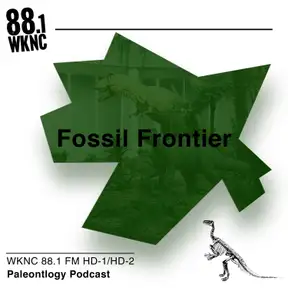La Brea Tar Pits: The Fossil Site With One Big Mystery
Download MP3Scrimble 0:06
Hello everybody. I'm scrimble, and welcome to the fifth episode of my podcast, fossil frontier, a paleontology podcast brought to you by wknc 88.1
this show will be dedicated to talking about my favorite fossils and prehistoric phenomena, we're going to explore some of Earth's ancient treasures and uncover the stories that they have to tell. So if that's something you're into, you better lock in, because this week we're talking about the La Brea Tar Pits. This is one of the most interesting fossil formation sites in the world, home to a wide array of animals, from mammoths and bears to ground sloths and even a single human.
Okay, So picture this. It's about 14,000 years ago, and you're a mastodon searching for food in a sunny area on the west coast of North America. As you graze on leaves and branches, you step onto an otherwise unremarkable patch of foliage, when suddenly you find yourself ankle deep in a sticky, black goo, you trumpet your alarm as your massive legs sink into the viscous, treacherous tar. With every frantic struggle, the substance clings tighter, pulling you deeper into its inescapable depths. After tireless struggling, the area falls silent, your mighty roars fading into mournful echoes swallowed by the ancient, unyielding embrace of the tar pit. Unfortunately, this wouldn't be the end of the pit's wrath, because smelling the freshly deceased corpse of the mastodon, predators such as the smilodon or direwolf would try to scavenge the body, only to be met with the same fate.
But how did these pits get there, and how would they become the famous fossil site that we know today?
Well, the La Brea Tar Pits sit on a large oil reserve in present day Los Angeles. Natural faulting in the area about 50,000 years ago, caused underground crude oil deposits to surface and form the pits.
When exposed to the atmosphere, the oil dried out and formed a sticky tar, perfect for entrapping any animal that dared to set foot in it, as well as any other organic matter that even touched the surface.
But it was also perfect for preserving these organisms. The pits shielded them from oxygen and sunlight, leading to over 3 million fossils and counting having been discovered to date.
The pits also preserved flora and fauna from a period of significant climate change in the area, the Wisconsin glaciation, which peaked around 20,000 years ago and marked a much cooler and moister North America than we know today.
Furthermore, the pits also saw the introduction of humans to the ecosystem around 15,000 years ago, many of the fossils discovered from around this time bear tool marks that could have came from human butchering activities. However, these markings have yet to be definitively named as being caused by humans.
One unmistakably human fossil, however, is that of the La Brea woman, the only human fossil found in the pits. These remains are from about 10,000 years ago and contain the partial skeleton of a roughly 20 year old woman who was four foot nine and ate mostly stone ground meal. She seemed to belong to the Chumash people, a group of Native Americans who were known to use the tar from the pits to seal their canoes to make them watertight. But the woman ending up in these pits was no boat accident.
There are a few theories on what happened surrounding her death and ultimate burial in the tar pit. Originally, paleontologists discovered the remains of a domesticated dog located not far away from where they found the woman. So they assumed that both corpses were ceremonially buried in the pits. But this would not explain why only one human was ever found, and it was later discovered that the dog fossil was about 7000 years younger than the woman, so that couldn't be it.
But upon further research, paleontologists noticed that the woman had a fractured skull caused by a blow to the head. That was likely what killed her. It's theorized that she could have been attacked by an animal and fell into the pit, or, more interestingly, murdered and very unceremoniously dumped into the pit to hide the body.
Was this the work of a prehistoric killer or just a simple accident? The world may never know,
but we do know one thing, a 20 year old woman found submerged in tar from 10,000 years ago with no explanation.
As to how she got there, she should have been in the club.
Ultimately, no matter how each individual specimen ended up in the pits, they still stand today as one of the most impressive and well preserved fossil formations in the world. As humans continued to settle in the area, they built right over the pits to form sunny Los Angeles, but the history and tragedy of the pits still remain, seeping out of the ground every day. These ancient asphalt seeps, having ensnared countless creatures over tens of thousands of years, offer a unique window into the past that's still being studied today.
Hopefully, with more research, we can gain further knowledge of the ancient world and solve Millennium old mysteries lurking just beneath the surface of the tar
Thank you for listening to the fifth episode of fossil frontier. This has been a wknc podcast. Good night, and I love you.
The audio used in this podcast was Song Thrush nature, field recording, garden atmo, recorded by gruda 1982 under Creative Commons license
Transcribed by https://otter.ai

